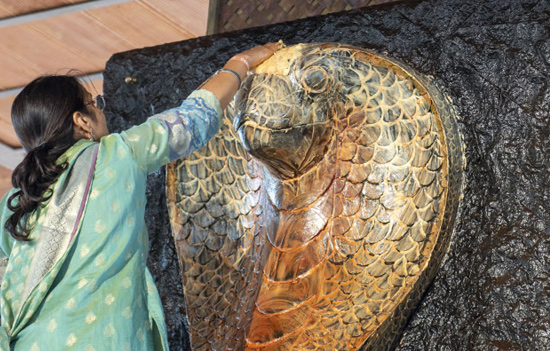- Know about
deeper significance behind Why Do We Offer Butter, Milk, Honey and Ghee in Our
Temples?
Benne is the
kannada word for butter. It was one of the first Kannada words I learned,
thanks to Davangere's famous Benne dosa. These are soft and fluffy dosa made
with dollops of butter.
Thus, when I saw benne offering at the Naga temple at Sadhguru Sannidhi Bangalore, I knew what it meant. But I was a little surprised because I was familiar with milk and water offerings in temples. I couldn’t recall butter being offered in any other pooja ritual.
Every Pournami
and Amavasya, devotees get the chance to apply specially-prepared butter to the
large Naga murti at this temple. This process lasts about 45 minutes during
which the devotee has close contact with the Naga murti. There are multiple
time slots each day to do this seva, devotees can book it on this
website page.
Butter
Offerings in Temples
Curious about butter as an offering, I did some research around it. “Benne alankara is very common in Hanuman and Krishna temples” mentioned one of my Kannadiga friends.
Krishna’s love for butter is well-known, so it makes sense that it would be a common offering in Krishna temples. I also came across a story where Rama applies Butter to heal wounds of Hanuman received during the battle with Ravana. Thus, butter is sometimes offered in Hanuman temples.
Further, I discovered that the Abhishekam ritual with eleven offerings in Sadhguru’s Linga Bhairavi temples starts with Navaneetam. Navaneetam means ‘fresh butter’. Right under my nose, here in the center, butter is being offered for this other pooja ritual, and I was unaware of it!
Our Indic rituals are so diverse and complex, that a lot of us often don’t know many simple things. I was glad to know more about Butter as a temple offering.
In Bangalore,
there is an 18-feet tall Dodda Ganesh murti located on Basavanagudi road.
During its week-long Ganesha festival, the murti is adorned with 100 kgs of
butter and is a big attraction for the devotees!
All this is
fascinating but the question comes up: why do we apply butter, ghee and other
such substances on our idols? Is it only about decorating it? Or is there a
deeper reason?
Why
Do We Offer Milk, Honey and Ghee in Our Temples?
Sadhguru has
earlier spoken about the significance of these rituals where oil, ghee, milk or
similar substances are offered to stone shiv lingas.
Sadhguru says, “A stone linga which is kept for worship, or whatever else, it may be, if you don’t feed it with some kind of fat or oily material either ghee or milk or something like this. It will crack. It will become brittle and crack over time. So, periodically, you have to apply either oil or ghee or milk or whatever you like. Something through which the stone can absorb fatty material so that there is integrity to the stone. So, once you are worshiping something, you don’t want it to crack up. It is a certain maintenance.
And also, if the linga is properly consecrated, it
will reverberate better if it remains wet. See if you apply oil, or ghee or
even milk, the fat of the milk, the linga remains wet all the time. As I said
earlier, you have to keep your body wet to receive. And similarly, linga has to
be wet for it to exude. So a simple way of keeping it wet is, soak it in oil,
ghee, honey or milk which will keep it wet for a long period of time.
If I pour water, that also is being done, it will
remain for 10 minutes and then dry up. But if I pour milk, it stays wet for
months on end because the fat has entered the pores in the rock” (source)
In the Naga temple, the murti is made of stone. Even on the days when benne seva is not happening, we will find the main stone to be quite oily. Applying butter to the Naga murti is not only about the close contact the devotee has with Naga, but it also improves the receptivity to Naga’s energies.

On specific
days, the Naga shrine is washed from top to bottom in water. I have often
volunteered here for this washing seva. And definitely one can feel a deeper
experience of the temple energies with all the water on the murti.
To read all articles by author
Author Priyanka
Dalal has a profound love for spiritual exploration and travel. She documents
her adventures on her blog MapRoute and youtube channel
InSpirituality